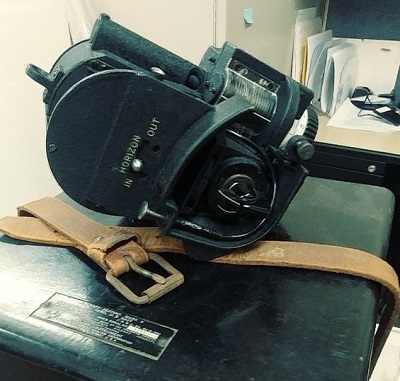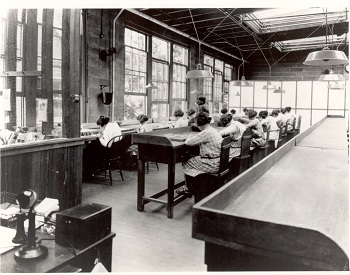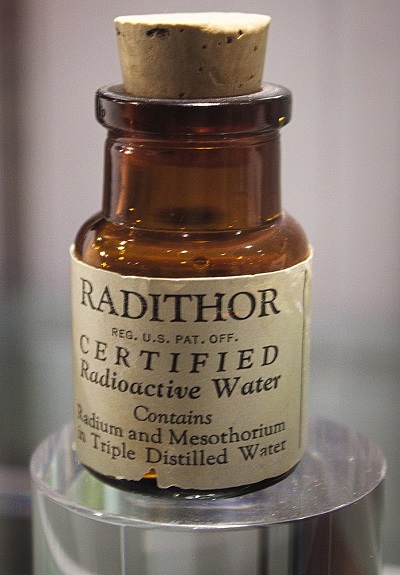Marie Curie was perhaps the first “rock star” scientist – she was smart, hard-working, attractive, had survived tragedy, and made history as the first woman to win the Nobel Prize in an era in which women’s role in science was more likely to be that of cleaning up the lab than organizing it. And when the world heard about this petite Polish woman, laboring in obscurity in a makeshift laboratory in Paris, who had discovered not one, but two new elements (radium and polonium) – both of them radioactive, at a time when radioactivity itself was novel and exciting the world was enchanted with Madame Curie, her story, and the radium she had discovered.
Within a few years of its discovery radium’s ability to cause skin burns had been noted, along with appropriate protective measures. By the end of the first decade of the 20th-century people knew how to work safely with radium and they were beginning to tease out some uses for this novel material.
In industry, for example, radium was quickly found to cause a suspension of zinc sulfide to emit light; mixing radium into such a suspension produced a paint that glowed in the dark. Not only that, but mixing zinc sulfide and radium into plastic created a plastic that glowed in the dark. Between the paint and the plastic, virtually anything could be made to glow in the dark.
Some of these products were made for the military; self-luminous dials for airplane instruments, self-luminous nautical navigational instruments, glow-in-the-dark patches soldiers put on their shoulders to help the person behind them follow more easily (these were great to put next to doors, light switches, and the like at home as well), and compasses that could be read in the dark were among the most common.

U.S. Navy Aircraft Sextant, Mark V (Pioneer Instruments/Bendix, part 3014-2-A). These bubble sextants were used by large planes (Mostly Bombers) during WWII to navigate by the stars (over the Atlantic or Pacific Oceans) where the natural horizon was not visible and replaced by the bubble. It had electric lights for standard illumination and radium for low-intensity illumination.
A few years ago, I was asked to survey a sextant that had radium-based paint – it didn’t give off high radiation levels, but they were clearly higher than background. And a few years before that I’d responded with the NYPD to a storage area that held a collection of antique military compasses – also with radium-painted numbers and hashmarks. Radium let people see things in the dark, and the public loved it as much as the soldiers, fliers, and sailors.
What’s interesting is that companies started using “radium” in product names, even when the product contained nary a trace of the element. In the BBC documentary Nuclear Nightmares (which was about radiation phobia) health physicist Paul Frame commented on this:
“The word radium meant ‘quality.’ It’s the equivalent today of ‘gold’ or ‘platinum.’ I have a platinum credit card; back then you’d have had a radium credit card. So they had radium condoms, radium cigarettes, radioactive toothpaste, radium show polish – not radioactive, but using that word “radium” to connote high quality.”

I mentioned earlier that radium was used to paint glow-in-the-dark dials for watches, aircraft instruments, compasses, and so forth. What I didn’t mention was that these dials were painted by hand and the vast majority of those hands belonged to young women working for one of the companies making these dials. The girls doing this work were trained to twirl the brush briefly in their lips or against their tongue to assure a good point for painting the fine lines; when they did this they ingested tiny amounts of radium. Over time, this radium was deposited in their bones and exposed them to high levels of radiation; in 1922 the first “Radium girl” died from radiation exposure, followed by an increasing number of others in subsequent years. For many, this was the first indication that radium might not be purely good.

Reference:
https://en.wikipedia.org/wiki/Radithor#/media/File:Radithor_bottle_(25799475341).jpg
Radium was also a huge hit in the medical arena. When it was discovered that radium could cause skin burns, physicians made the leap to realizing it might also be used to burn out cancers or other unwanted tissues. But then the quacks got their hands on radium, mixing it in with patent medicines such as Radithor. One problem with Radithor was that it killed its most prominent user, amateur athlete and industrialist Eben Byers, in 1932, after drinking an estimated 1400 bottles over the previous five years. Radium is a bone-seeking element (it replaces calcium in the bone) and Byers’ teeth, jaws, and bones were rotting away.
The Radium Girls, Eben Byers, and others who over-indulged in radium patent medicines were the first people to come to the attention of the general public to be injured by radiation. And they were sympathetic characters – young women and a famous socialite, athlete, and industrialist. By the time that Byers died, dozens, if not hundreds of Radium Girls had also become ill and many of them had died.
Within a decade of Byers’ death, radiation research would be plugging along at full speed in the US, a part of the Manhattan Project. In the 1950s, during the era of atmospheric nuclear weapons testing, the health effects of radiation manifested themselves more widely, culminating in the Atmospheric Test Ban Treaty.
A few decades more and environmental regulatory standards began to change, requiring the cleanup of the places where radium watch dials used to be produced. I was involved in one of these remediation projects, in central Illinois – overseeing radiation safety for the remediation. In addition to excavating thousands of cubic yards of contaminated soil, our radiation safety technicians found a radium source inside the wall of a house in town, a source that had been there for over a half-century. More interestingly, we also found a flagpole that had been painted with radium paint – apparently, it was in front of the house that had once been the governor’s home and, in the 1920s, it was felt that the governor’s flagpole should stand out (this particular vanity ended up resulting in over 10 cubic yards of contaminated soil, that had to be painstakingly excavated around a number of buried utility lines).
Since the golden age of radium attitudes towards radiation have changed dramatically. I began working with radiation in 1981 and, frankly, it’s hard for me to picture an era in which the public was enthusiastic about radiation and viewed it with hope and excitement rather than fear. But it’s awfully nice to fantasize about.